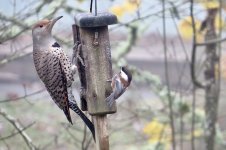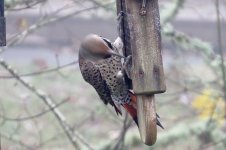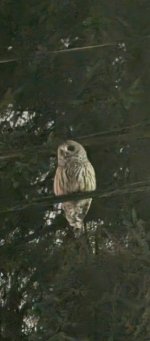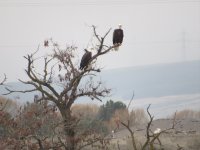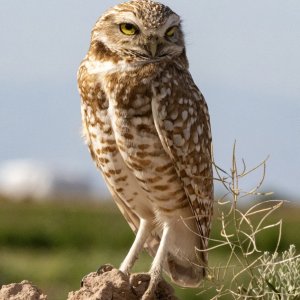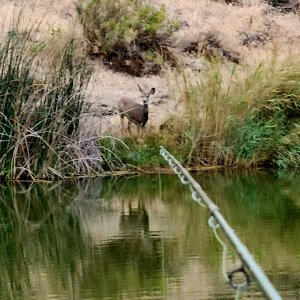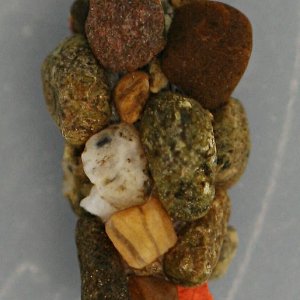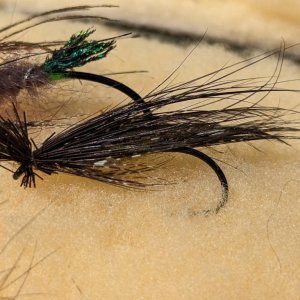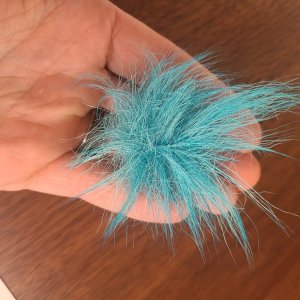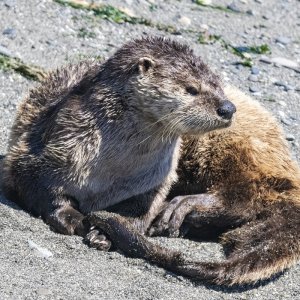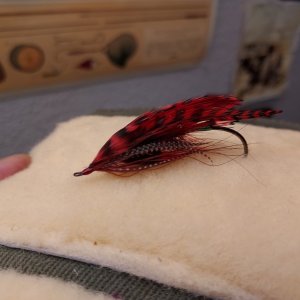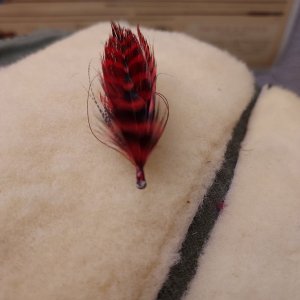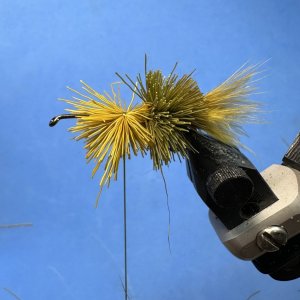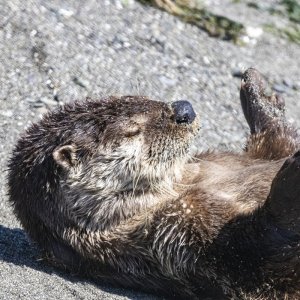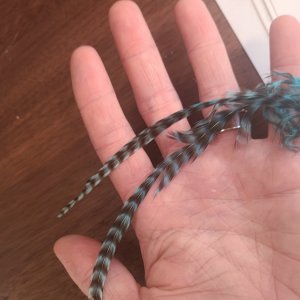You are using an out of date browser. It may not display this or other websites correctly.
You should upgrade or use an alternative browser.
You should upgrade or use an alternative browser.
Got any bird pics?
- Thread starter Wadin' Boot
- Start date
Nisqually Wildlife Refuge, December 2023, Part 4 of 5
In summer, many species of the insectivorous birds are active in the early morning and just before sunset with a siesta at midday. But in winter, they sleep-in and wait for the temperatures to rise. They seem to forage first in the trees hits by the rising sun. At the end of the day, they forage in the last trees hit by the setting sun.
In summer, the flocks are more localized and smaller, an adult pair and their fledglings perhaps. But in winter, multiple families will join up and the flocks will include multiple species. Common mixes in winter include black-capped chickadees and chestnut-backed chickadees who will search from the trunk to the thinnest branches.
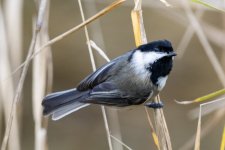
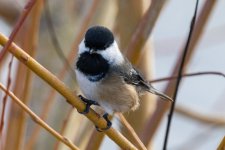
Often you might find a lone brown creeper climbing up the tree trunk in the middle of the group.
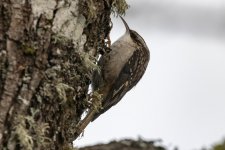
One or two ruby-crowned kinglets may add their frenetic energy to the flock.
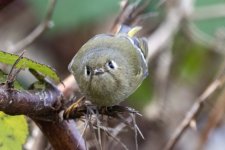
On occasion, you can find a downy woodpecker in the mix as well.
Flocks of golden-crowned kinglets will cover the same territory, but they will not consistently join the chickadees. These are some of the tiniest non-hummingbird species in North America at 4-8g (3 dimes = 6.8g…).
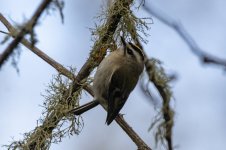
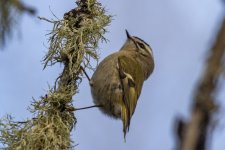
A passing flock can be recognized by their distinctive high-pitched “tsee” calls that maintain flock cohesion. Like the ruby-crowned kinglets, these birds are always on the move.
Steve
In summer, many species of the insectivorous birds are active in the early morning and just before sunset with a siesta at midday. But in winter, they sleep-in and wait for the temperatures to rise. They seem to forage first in the trees hits by the rising sun. At the end of the day, they forage in the last trees hit by the setting sun.
In summer, the flocks are more localized and smaller, an adult pair and their fledglings perhaps. But in winter, multiple families will join up and the flocks will include multiple species. Common mixes in winter include black-capped chickadees and chestnut-backed chickadees who will search from the trunk to the thinnest branches.


Often you might find a lone brown creeper climbing up the tree trunk in the middle of the group.

One or two ruby-crowned kinglets may add their frenetic energy to the flock.

On occasion, you can find a downy woodpecker in the mix as well.
Flocks of golden-crowned kinglets will cover the same territory, but they will not consistently join the chickadees. These are some of the tiniest non-hummingbird species in North America at 4-8g (3 dimes = 6.8g…).


A passing flock can be recognized by their distinctive high-pitched “tsee” calls that maintain flock cohesion. Like the ruby-crowned kinglets, these birds are always on the move.
Steve
Nisqually Wildlife Refuge, December 2023, Part 5 of 5
The waterfowl density and diversity at Nisqually is amazing; I have seen 16 species of ducks alone and four species of geese there. And they will typically allow MUCH closer approach by a birder on foot (and “armed” with a big camera with zoom lens, even in the middle of the hunting season), than individuals of the same species will allow at Ridgefield Wildlife Refuge when viewed from within a car.
After several weeks of fall rain, there is finally enough water in the main pond by the Visitor Center to support diving ducks. There have been buffleheads diving in the estuarine section of McAllister Creek for several weeks, but they only expanded their range to the pond at the start of December.
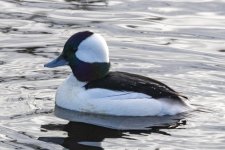
Joining the buffleheads, ring-necked ducks, with their slicked-back 50's do, explore the pond bottom for snacks too.
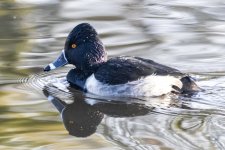
Green-winged teals are less likely to be found foraging in the pond; they are far more common in the freshwater marsh or especially along the margins of the mudflats where they energetically filter-feed on fine organic material and tiny algae.
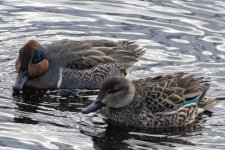
The pond is a reliable spot to observe mallards, but they can also be found feeding/resting in the canals and in the freshwater marsh; I don’t commonly see mallards on the saltwater side of the refuge.
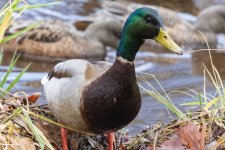
I often encounter Northern shovelers engaged in their distinctive “vortex-feeding” (i.e., spinning around a single point while filtering water through the fine lamellae in their bills) in the open-water sections of the freshwater marsh; they will also engage in the same behavior in the canals along the boardwalk of the Twin Barns loop.
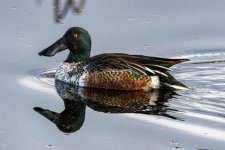
Northern pintails dig deep into the roots of the seasonally-flooded grasses or freshwater marsh. The males are so elegant in their breeding plumage. Occasionally, I see pintails flying back and forth between the freshwater marsh and the salt-water mud-flats, but on the saltwater side they keep enough distance from the gravel dike that I can’t clearly see what they are doing.
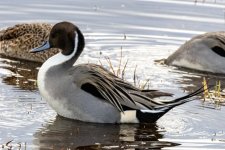
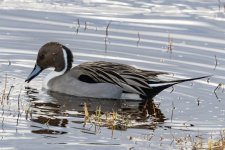
American coots are the Rodney Dangerfields of the bird world – no respect. But they are quite successful and flexible in habitat, feeding behavior, and diet; so, they must be doing something right.
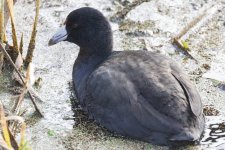
Steve
The waterfowl density and diversity at Nisqually is amazing; I have seen 16 species of ducks alone and four species of geese there. And they will typically allow MUCH closer approach by a birder on foot (and “armed” with a big camera with zoom lens, even in the middle of the hunting season), than individuals of the same species will allow at Ridgefield Wildlife Refuge when viewed from within a car.
After several weeks of fall rain, there is finally enough water in the main pond by the Visitor Center to support diving ducks. There have been buffleheads diving in the estuarine section of McAllister Creek for several weeks, but they only expanded their range to the pond at the start of December.

Joining the buffleheads, ring-necked ducks, with their slicked-back 50's do, explore the pond bottom for snacks too.

Green-winged teals are less likely to be found foraging in the pond; they are far more common in the freshwater marsh or especially along the margins of the mudflats where they energetically filter-feed on fine organic material and tiny algae.

The pond is a reliable spot to observe mallards, but they can also be found feeding/resting in the canals and in the freshwater marsh; I don’t commonly see mallards on the saltwater side of the refuge.

I often encounter Northern shovelers engaged in their distinctive “vortex-feeding” (i.e., spinning around a single point while filtering water through the fine lamellae in their bills) in the open-water sections of the freshwater marsh; they will also engage in the same behavior in the canals along the boardwalk of the Twin Barns loop.

Northern pintails dig deep into the roots of the seasonally-flooded grasses or freshwater marsh. The males are so elegant in their breeding plumage. Occasionally, I see pintails flying back and forth between the freshwater marsh and the salt-water mud-flats, but on the saltwater side they keep enough distance from the gravel dike that I can’t clearly see what they are doing.


American coots are the Rodney Dangerfields of the bird world – no respect. But they are quite successful and flexible in habitat, feeding behavior, and diet; so, they must be doing something right.

Steve
Last edited:
Just wonderful stuff Steve, thanks so much for the great shots and accompanying information.
Cheers
Cheers
Yes, wonderful. Creepers are a hard bird to spot, nice picture. And, of course, the other pictures are great. Don't see many ring-necked ducks.
Ditto on the fabulous images - thanks as always for sharing!
When I see shovelers engaged in the circling feeding behavior, I call that doing the "rotifer roundup". I've seen crop samples from a shoveler food habits study that were gorged with almost microscopic rotifers. As Steve mentions, they have fine lamellae and commonly feed on rotifers, copepods, anomopods, and other tiny critters.
Greenwing teal (smallest North American puddle duck) can also forage on small food items but they are mostly vegetarian (especially small seeds) while on the wintering grounds. Like other puddle ducks, their intake of invertebrates increases later in winter and spring as they pack in protein for migration, egg laying and brood rearing.
When I see shovelers engaged in the circling feeding behavior, I call that doing the "rotifer roundup". I've seen crop samples from a shoveler food habits study that were gorged with almost microscopic rotifers. As Steve mentions, they have fine lamellae and commonly feed on rotifers, copepods, anomopods, and other tiny critters.
Greenwing teal (smallest North American puddle duck) can also forage on small food items but they are mostly vegetarian (especially small seeds) while on the wintering grounds. Like other puddle ducks, their intake of invertebrates increases later in winter and spring as they pack in protein for migration, egg laying and brood rearing.
I have seen pink-eared ducks (singly and in pairs) in Australia use vortex feeding and filtering. The rotational action concentrates prey in the center of the vortex for more efficient feeding. Phalaropes are also known for vortex feeding, but they then use their bills to pick out individual planktonic items.Ditto on the fabulous images - thanks as always for sharing!
When I see shovelers engaged in the circling feeding behavior, I call that doing the "rotifer roundup". I've seen crop samples from a shoveler food habits study that were gorged with almost microscopic rotifers. As Steve mentions, they have fine lamellae and commonly feed on rotifers, copepods, anomopods, and other tiny critters.
Greenwing teal (smallest North American puddle duck) can also forage on small food items but they are mostly vegetarian (especially small seeds) while on the wintering grounds. Like other puddle ducks, their intake of invertebrates increases later in winter and spring as they pack in protein for migration, egg laying and brood rearing.
At Nisqually, the green-winged teals definitely prefer the edges of the mudflats, not the adjacent freshwater marsh or flooded fields. I suspect that they are filtering diatoms and other microscopic organisms from the mud surface. They actively feed right at the water's edge and follow the tide up and down the mud flats.
Steve
Last edited:
Most likely protecting territory this time of year. They get aggressive around feeders this time year. We have at least three that compete at ou feeder
Nuptial displays have a pattern and are generally a spring thing.
Nuptial displays have a pattern and are generally a spring thing.
Three of us had just launched our various pontoons or pram at Leighton Lake (BC). I'd anchored up a few dozen yards from the launch to get one of my rods fully rigged when two families of Canadian geese swam by, the goslings were maybe 1/2 the size of their parents except for one runt gosling that was bringing up the rear of the swimming birds. The two families swam ashore with the runt sturggling to get up a steep bank. About that time several ravens congregated in nearby trees making a heck of a racket. Suddenly a couple ravens swooped down and attacked the small gosling, the adult geese flared up to defend the little bird - that worked for a few seconds until several more ravens swooped down. It seemed as if the ravens were distracting the adult geese so the birds attacking the gosling could finish the kill. The gosling was killed and pretty much torn up at the edge of the lake, the geese moved on. Feast time for some noisy ravens.Crows visit my bird feeder which is a plastic tabletop. On occasion, I see them on my backyard neighbors' roof eating something small. I hope it is not hummingbirds.
Gyrfalcon22
Life of the Party
Now I have a backyard shrike for the first time ever. It is amazing that they are not much bigger than a Starling. A tad stockier. A bandit with an assassin's mind.
This time of year is a tough one where I live when I walk the rural roads and fields. I see far too many badly injured birds from sporting activities. This Dunlin was not long for this world a couple days back. I had to put down a snipe with a wing blown off a couple weeks ago.
This time of year is a tough one where I live when I walk the rural roads and fields. I see far too many badly injured birds from sporting activities. This Dunlin was not long for this world a couple days back. I had to put down a snipe with a wing blown off a couple weeks ago.
Last edited:
Gyrfalcon22
Life of the Party
This is the time of year I go back over shots of Snowy Owls from the Winters of 2012 and 2013. Rare back to back years we had irruptions on the coast. These migrations average about once every 7 years. Well, math being what it is we have not had them in 11 straight Winters now, fittingly.
Was hoping to get the word out to @Cabezon that they were here but another lost year looks to be in the books and I am stuck looking at old photos of these absolutely incredible birds. Being fairly close to many wild creatures is amazing, but these birds are off the charts magical !
Was hoping to get the word out to @Cabezon that they were here but another lost year looks to be in the books and I am stuck looking at old photos of these absolutely incredible birds. Being fairly close to many wild creatures is amazing, but these birds are off the charts magical !
Last edited:
Numerous snowy’s at Damon point a few years ago. Really cool.
@CabezonNisqually Wildlife Refuge, December 2023, Part 4 of 5
In summer, many species of the insectivorous birds are active in the early morning and just before sunset with a siesta at midday. But in winter, they sleep-in and wait for the temperatures to rise. They seem to forage first in the trees hits by the rising sun. At the end of the day, they forage in the last trees hit by the setting sun.
In summer, the flocks are more localized and smaller, an adult pair and their fledglings perhaps. But in winter, multiple families will join up and the flocks will include multiple species. Common mixes in winter include black-capped chickadees and chestnut-backed chickadees who will search from the trunk to the thinnest branches.
Often you might find a lone brown creeper climbing up the tree trunk in the middle of the group.
One or two ruby-crowned kinglets may add their frenetic energy to the flock.
On occasion, you can find a downy woodpecker in the mix as well.
Flocks of golden-crowned kinglets will cover the same territory, but they will not consistently join the chickadees. These are some of the tiniest non-hummingbird species in North America at 4-8g (3 dimes = 6.8g…).
A passing flock can be recognized by their distinctive high-pitched “tsee” calls that maintain flock cohesion. Like the ruby-crowned kinglets, these birds are always on the move.
Steve
There is a park out here in the TriCities where this sort of winter feeding guild, almost exactly as you describe, is hanging out: Two Rivers Park.
There are black-capped chickadees and ruby crowned kinglets, along with brown creepers and downy woodpeckers. Once you see one, you are likely to see the rest.
Golden crowned kinglets are heard but seldom seen. White breasted nuthatches were seen by a couple of birders but may have moved on. Last Thursday I also saw redbreasted nuthatches.
Here is some evidence of the redbreasted nuthatches, albeit from far away in dim foggy light using high iso setting. I was happy to get the photographic confirmation and the nuthatch silhouettes.
Jay
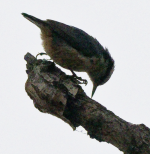
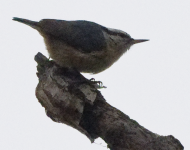
Thanks for the pics and observations.

